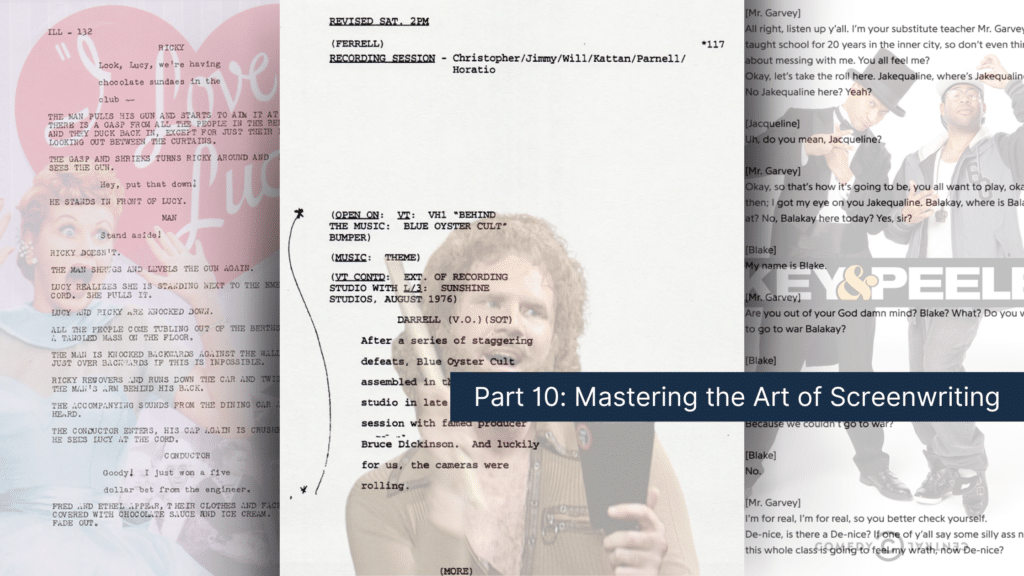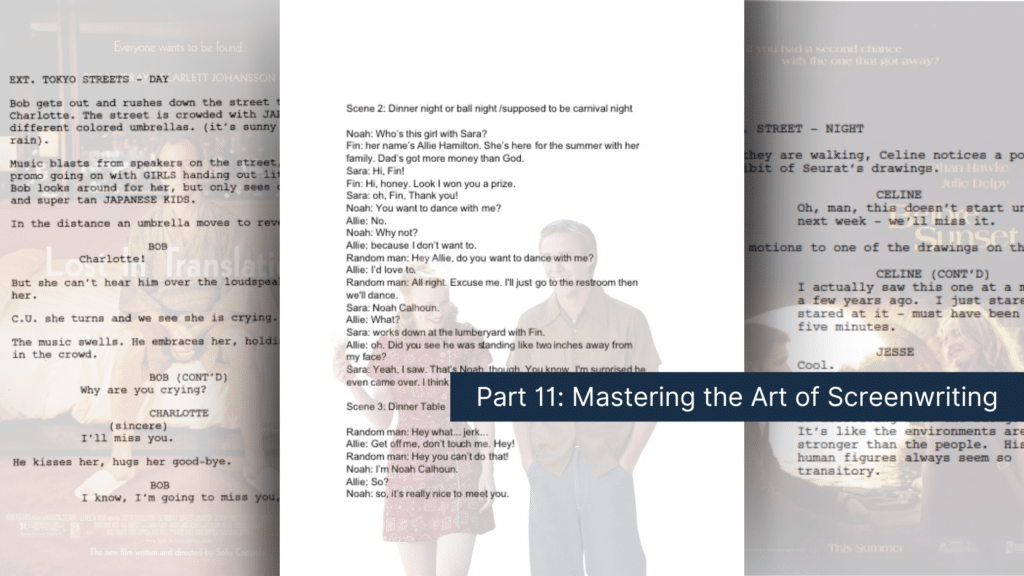
This is part 10 of the Celtx Screenwriting Series: Learn to Write a Script in Every Genre
Start from the beginning here!
How to Write a Skit: An Introduction to Sketch Comedy
Humor is everywhere—from TV and film to everyday conversations. Writing a skit lets you turn ideas into quick, engaging performances, whether it’s a comedy sketch, a dramatic vignette, or a playful scene.
But what makes a skit truly land? In this guide, we’ll walk you through the essentials of writing a skit that captures attention and gets laughs (or gasps!) every time. From structuring your skit to using modern tools for faster writing, you’ll be ready to bring your ideas to life.

What Is a Skit?
A skit (or sketch) is a short, scripted performance that typically lasts anywhere from a few minutes to about ten minutes. Designed to entertain, educate or convey a specific message, skits can be used in many different contexts.
You’ll probably be most familiar with comedy skits in TV and comedy shows. Think the iconic sketches from Saturday Night Live (SNL), Key and Peele, or The Carol Burnett Show. Skits are also very popular in theatre productions, namely variety shows or as part of a larger performance.

Outside of the entertainment world, skits are also used for corporate events or in educational settings. For example, skits are a great resource for teams to communicate key ideas during meetings or training sessions. Teachers often use skits to engage students and make learning more interactive.
So, what exactly is the appeal of skits for these different mediums? Well, essentially, their appeal lies in a skit’s brevity and focus. With limited time, skits rely on concise storytelling, sharp dialogue, and memorable characters, all which leave a lasting impression on audiences.
Now it’s time for us to do the same as we take a deep dive into how to write your script.
How to Structure Your Skit
Even though skits are short, they still follow the basic principles of storytelling: a beginning, a middle, and an end. Let’s break it down, with a little help from the famous Substitute Teacher sketch from Key and Peele.
Whether you call it Celtx, Celtex, or Celtix (we see you, substitute teacher),
it’s the go-to software for writing and producing your skits.
Sign up for free and get started today!
The Beginning
The opening of your skit should set the tone and immediately capture the audience’s attention. Introduce the setting, main characters, and the premise as efficiently as possible.
You could use humor, intrigue, or a surprising hook to draw viewers in. The beginning of Substitute Teacher immediately establishes the classroom setting, introducing Mr. Garvey, a substitute teacher with a hilariously stern demeanor and a tendency to mispronounce names.
Here, the comedic premise is set up right away, allowing the audience to easily engage.
The Middle
Here is where the main action unfolds and should build momentum. Your skit could revolve around a comedic misunderstanding, a dramatic conflict, or a clever twist. What’s important is to keep the pacing tight and ensure every line or action serves the story.
Returning to Substitute Teacher, the middle section of the skit highlights escalating misunderstandings as Mr. Garvey continues to mispronounce names, leading to increasingly frustrated reactions from students. This only amplifies the humor as the characters’ eccentricities feed off each other, causing chaos.
The End
Now its time to deliver the punchline and an ending that feels satisfying. Tie up any loose ends to leave your audience with a lasting impression. There was no way that the ending of Substitute Teacher was going to leave audiences wanting more. It features a climactic misunderstanding with a student named Denise, meaning the skit is wrapped up with a sharp and memorable punchline that cements the humor that the premise set up right at the start.
Learn more about how to write skits or screenplays using the Three Act Structure with our comprehensive guide.
Click here!

Tips for Writing a Great Skit
Structure is only one side of the coin when it comes to writing a great skit. The other involves careful thought and creativity. Here are some of our top, practical tips you can use to craft a memorable skit.
Use Humor Effectively
If your skit is comedic, focus on timing and relatable scenarios. Humor often comes from exaggeration, irony, or unexpected twists. Avoid overly complicated jokes that could confuse your audience. Returning to Key and Peele, take a look at how their original East/West College Bowl skit uses impeccable timing and relatable scenarios to enhance its comedic impact on the audience.
Prioritize Pacing
Skits move quickly, and you only have limited time, so every second counts. Cut out unnecessary dialogue or actions that don’t contribute to the story. Keep the energy high to maintain audience engagement. Pacing plays a significant role in the classic Abbott and Costello skit, Who’s On First? Tight timing throughout the skit keeps the audience engaged throughout.
Know Your Audience
Talking of audience engagement, it’s crucial that you tailor your skit to the preferences and sensibilities of your target audience. What’s hilarious to a group of high school students may not resonate with a corporate audience, for example.
Consider why you’re writing the skit and who it’s aimed at.
Looking for a Celtx download? Good news — there’s nothing to install!
Celtx is cloud-based, so you can start writing your skit instantly from any device.
Try it for free
Focus on Relatable Characters
Characters should be at the heart of your skit. Even in a short performance, aim to create characters with clear motivations and personalities. This makes them more relatable and memorable. We all know someone just like the SNL 1990s favorite Matt Foley, Motivational Speaker. While not many of us can relate to him, his distinct personality is one that leaves a lasting impression. Instead of relating to him as a person, we relate to the situations his unfortunate listeners find themselves in.
Incorporate Visual and Physical Comedy
Primarily, skits are a visual medium. Take advantage of physical comedy, exaggerated gestures, and clever props to enhance the humor or drama. Mr. Bean is famous for leveraging physical comedy; it’s what the show is all about! He doesn’t say a word, yet we know exactly what he’s thinking and expressing just through his movements. Just like this skit when Mr. Bean finds himself in a sticky situation at an airport.
Collaborate with Others
If possible, workshop your skit with friends or peers. Their feedback could be valuable in helping you refine your script and identify areas for improvement.
Tools to Help You Write Skits
Writing skits doesn’t have to be a solo or paper-based process. Modern tools can streamline your workflow and enhance your creativity. While index cards and Google Docs can help you get started, professional software can help you save time and focus on what’s important – writing your skit!
Our powerful scriptwriting software, Celtx, offers a range of features tailored specifically to writers and creators. From idea inception to finished product, Celtx is here for you every step of the way as you write your skit, or any other scripted project for that matter!
Celtx Features that You Need to Try
Collaborative Tools
Celtx allows multiple users to collaborate on a script in real time. This is especially helpful if you’re co-writing with a partner or receiving input from a director.
Start collaborating with Celtx today!
Script Breakdown
Automatically break your skit down into scenes, props and character lists with our script breakdown feature. This makes it so much easier to plan rehearsals and your production schedule.
Accessibility
With a cloud-based interface, you can work on your skit from anywhere with anyone, whether you’re at home, away, or even on set.
Why not try out Celtx for yourself? Check out how we can help you here.
Famous Skits to Inspire You
While we hope our blog post today has been useful in helping you structure and write your skit, it always pays to gather inspiration from pre-existing work.
Looking at well-crafted skits can spark your creative juices and teach you valuable lessons about timing, humor, and storytelling. Seeing everything we’ve discussed in action, can be extremely useful in our own creative processes.
Here are some classic examples worth exploring:
Debbie Downer | Saturday Night Live
This hilarious set of skits stars Rachel Dratch as Debbie Downer, a character who constantly brings up depressing or awkward topics in social settings.
The combination of exaggerated reactions and the actors’ struggle to stay in character makes it a memorable and relatable example of SNL’s comedic style.
In the above example of a Debbie Downer skit, Debbie meets Bob Bummer (Steve Carrell) at a wedding reception with puzzling yet humorous consequences.
The Ministry of Silly Walks | Monty Python’s Flying Circus
A prime example of classic British humor, this sketch uses absurd physical comedy. John Cleese portrays a bureaucrat advocating for funding for silly walks.
This is a great one to take inspiration from if you’re looking to write a skit that uses visuals to drive its success.
What’s the best screenwriting software?
See how Celtx stacks up against Final Draft and why writers choose us for scripting, collaboration, and production planning.
Compare now
The Dinner Party | I Love Lucy
Another classic example for physical comedy, this skit utilizes Lucille Ball’s comedic genius perfectly. In this scene, a simple dinner party descends into chaos. Ball’s impeccable timing and physical comedy skills are nothing short of brilliant.
Lobster Bisque | Studio C
This skit humorously depicts a dramatic restaurant encounter where a waiter’s over-the-top delivery of lobster bisque descends into chaos.
We’ve all had a slightly odd experience in a restaurant, so this is a great example of how the situations we all encounter can be hilariously combined with strong character work.
The Job Interview | That Mitchell and Webb Look
Another famous British show, this comedy skit turns a mundane job interview into a surreal and absurd scenario. Clever dialogue and unexpected twists are the name of the game, showcasing how important it is to keep your audience engaged!
The Family | The Carol Burnett Show
One of the show’s most famous recurring sketches, The Family features the Burnett family (played by Tim Conway, Harvey Korman and Vicki Lawrence) sitting down to dinner. However, their conversations go completely off the rails.
In this example on the Burnett family’s game night, as always, each character takes their awkwardness and quirks to a whole new level with increasingly bizarre and outrageous behavior.
Date-zaster! | Scott Aukerman’s Dream Sequence
We’ve all been on a terrible date. Scott Aukerman knows that too, with this recurring skit.
In this mock dating show, the dates go horribly wrong in the strangest of ways. From overly competitive mini golf to disastrous karaoke performances, each date spirals into comedic chaos, making it a staple of the show’s absurd humor.
For more of our favorite comedy skits, check out our dedicated Saturday Night Live 50th anniversary post where we run down the best SNL skits from then and now.
Conclusion
Writing a skit is a rewarding creative process that allows for experimentation, humor, and concise storytelling.
By understanding the basic structure, beginning, middle, and end, and incorporating effective techniques such as timing, character development, and pacing, writers can craft engaging and memorable performances.
Tools like script writing software and collaborative platforms further streamline the process, offering additional support to refine ideas and maintain creative flow.
Whether you’re writing for a comedy show, corporate event, or educational setting, the key is to connect with your audience through relatable characters and sharp, well-timed humor. Drawing inspiration from iconic skits from shows like Saturday Night Live, Monty Python’s Flying Circus, or The Carol Burnett Show, can provide valuable insights into successful skit writing. By combining structure, creativity, and audience awareness you’ll be well on your way to writing skits that leave a lasting impression.
Up Next:

How to Write a Romance Script That Sweeps Audiences Away
Want to write a romance script that captivates audiences? Learn how to craft compelling love stories, balance romance with other genres, and create unforgettable on-screen chemistry.
Or choose any genre from our series:
- Part 1: Intro to Mastering the Art of Screenwriting
- Part 2: From Dreams to Screams: How to Write a Horror Script
- Part 3: From Dreams to Screams: How to Write a Horror Script Part 2
- Part 4: Beyond the Stars: How to Write a Science Fiction Script
- Part 5: Laugh Out Loud: How to Write a Comedy Script
- Part 6: From Tears to Triumphs: How to Write a Drama Script
- Part 7: From Meet-Cutes to Happy Endings: How to Write a Rom-Com Script
- Part 8: Crafting Magic: How to Write a Holiday Movie Script
- Part 9: How to Write a Documentary Script: A Step-by-Step Guide
- Part 12: From Clues to Conclusions: How to Write a Mystery Script
- Part 13: From Song to Stage: How to Write a Musical Script
- Part 14: From Zero to Hero: How to Write an Action Movie Script
